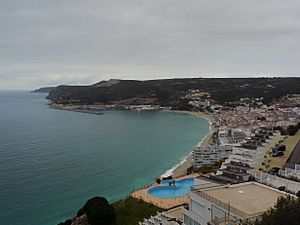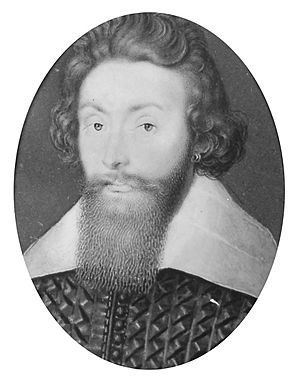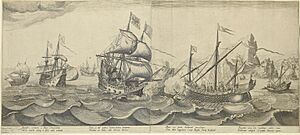Battle of Sesimbra Bay facts for kids
Quick facts for kids Battle of Sesimbra Bay |
|||||||
|---|---|---|---|---|---|---|---|
| Part of the Anglo-Spanish War (1585) | |||||||
 Sesimbra Bay as seen today. |
|||||||
|
|||||||
| Belligerents | |||||||
| Commanders and leaders | |||||||
| Strength | |||||||
| 11 galleys, 1 carrack, Fort and various shore defenses |
5 galleons, 2 prizes |
||||||
| Casualties and losses | |||||||
| 1 carrack captured, 2 galleys sunk, 1 fort immobilized, 800 killed or wounded |
12 killed, 30 wounded | ||||||
The Battle of Sesimbra Bay was an important sea fight that happened on June 3, 1602. It was part of the Anglo-Spanish War. This battle took place near Sesimbra Bay in Portugal.
English ships, led by Richard Leveson and William Monson, fought against Spanish ships. The Spanish fleet included fast galleys and a very large cargo ship called a carrack. The Spanish forces were commanded by Álvaro de Bazán and Federico Spinola.
The English won this battle. They sank two Spanish galleys and forced the rest to leave. They also stopped the nearby fort from firing and captured the huge Spanish carrack. This was the last time Queen Elizabeth I sent ships to attack Spain before she passed away the next year.
Contents
Why the Battle Happened
Queen Elizabeth I of England wanted to stop Spain from attacking Ireland or England again. So, she decided to send a fleet of ships to the Spanish coast. Sir Richard Leveson was chosen to lead this mission. He was a skilled commander who had won battles against the Spanish before.
Leveson was supposed to have nine English ships and twelve ships from the Netherlands. However, the Dutch ships were late. So, Leveson sailed with only five ships on March 19. His second-in-command, Sir William Monson, stayed behind to wait for the Dutch. Soon after, the Queen ordered Monson to join Leveson right away.
Meanwhile, a Spanish commander named Federico Spinola had a plan. He wanted to invade England using many galleys. He was on his way to Lisbon when he got new orders. He was told to protect a very valuable Portuguese carrack. This huge cargo ship, named São Valentinho, was anchored in Sesimbra Bay. It was full of rich goods.
It wasn't until the end of May that the English fleets finally met. On June 1, the English ships were near Lisbon. They had captured two Spanish ships. Then, they heard that a large carrack and eleven galleys were in Sesimbra Bay. By this time, Leveson had only five ships left. Some had gone home because of illness or damage.
The Battle Begins
On the morning of June 3, Monson and Leveson found the Spanish ships. They were well-protected by the guns of Fort Santiago of Sesimbra. There was also an old Sesimbra Castle further inland on a hill. The Spanish fleet had eight galleys led by Spinola. Three more galleys, led by Álvaro de Bazán, had just arrived.
Around mid-morning, the English ships entered Sesimbra Bay. These ships included Monson's Garland, Leveson's Warspite, and Dreadnought. Also present were Nonpareil, Adventure, and two captured Spanish ships.
The Spanish galleys had large cannons at their front. They formed a tight defense around the São Valentinho carrack in the shallow water. As the English ships entered the bay, they immediately began firing. They kept their distance so the Spanish cannons couldn't hit them easily.
Monson's Garland fired its cannons at the Spanish galleys. This forced the galleys to break their tight formation. The Garland caused a lot of damage. The galleys started rowing from side to side to avoid the cannon fire. Leveson's Warspite had trouble with the wind and drifted out of range. Leveson then took a small boat to join Monson on the Garland.
When Bazán's galleys broke formation, the Dreadnought sailed right into the middle of the fight. It fired its cannons at close range. Bazán's galleys were all damaged, and he was badly wounded. This caused confusion among his ships. Monson then focused fire on Spinola's galleys. Within a few hours, two of Spinola's galleys, Trinidad and Occasion, were sunk. The captain of the Occasion was captured. The enslaved rowers on the galleys tried to swim to the English ships. Bazán's damaged galleys managed to escape.
Capturing the São Valentinho
The huge carrack was now surrounded. The remaining galleys under Spinola decided to retreat from the bay. Their ships were badly damaged, and the enslaved rowers were exhausted. The English were surprised when the cannons from Fort Santiago de Sesimbra started to fire less often. The English ships had fired accurately at the fort, putting most of its guns out of action within an hour. With the galleys destroyed or gone, it was clear the carrack was lost.
The English realized the carrack, São Valentinho, was a massive 1,700-ton ship. It had just returned from the Portuguese Indies full of valuable goods. The fort and other shore defenses could not fire much because they risked hitting their own ships. The English ships kept firing, silencing the remaining shore defenses.
The Garland and Dreadnought sailed up to the sides of the São Valentinho. English sailors quickly boarded the carrack. They secured the top deck with only a few losses. Monson wanted no more fighting.
The End of the Battle
Monson offered to talk, and the Spanish agreed. The battle was over. When Monson boarded the carrack, some Spanish officers recognized him. It turned out that the galley Leva, which had fled the battle, was the same galley that had captured Monson before. For Monson, this was a moment of revenge.
At first, the Spanish and Portuguese wanted to give the English only the cargo. They wanted to keep the ship with their flags flying. But Monson insisted on taking the whole ship. He promised to release all the prisoners. He also made the Spanish agree to stop firing and let the English leave safely. The Spanish could not burn the ship because the English ships surrounded it.
In the end, the Spanish agreed to the English terms. The São Valentinho was taken, and the fort stopped firing. The next day, after a friendly dinner with Spanish and Portuguese officers on the Garland, the English ships towed the São Valentinho away. The victorious English sailed back to Plymouth without any trouble.
What Happened Next
The Spanish suffered many losses, about 800 people were killed or wounded, mostly from the galleys. The Portuguese carrack São Valentinho was a huge prize. Its cargo was worth over a million ducats, which helped cover the costs of the English navy's summer operations. The São Valentinho was similar to another large ship, Madre de Deus, captured in 1592.
The English had very few casualties, only twelve killed and thirty wounded. Most of these were on the Garland. William Monson himself was almost killed when a cannonball hit his clothing.
When Monson and Leveson returned, Queen Elizabeth I welcomed them as heroes. The valuable goods from the carrack went to the crown. Leveson and Monson each received £3,000 from the Queen. Later, they both became admirals of the English Channel under King James I.
The Spanish viceroy of Portugal was very angry about the defeat and the loss of the carrack. He wanted to punish Don Diego Lobo, the Spanish commander. But Lobo escaped through a window with his sister's help and fled to Italy.
Bazán recovered from his wounds and continued to command galleys. Spinola suffered another defeat later that year. His remaining galleys were intercepted and destroyed by an English and Dutch fleet in the Battle of the Narrow Seas. Only Spinola's own galley escaped.
See also
Images for kids




